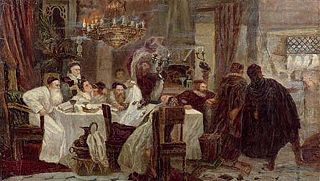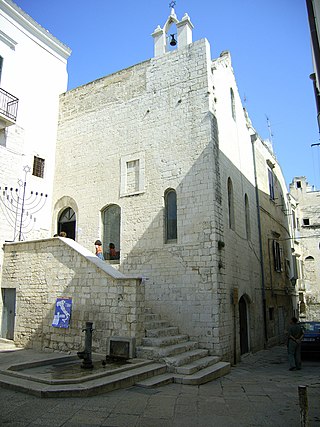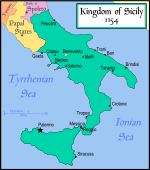
Marranos is a term for Spanish and Portuguese Jews who converted to Christianity, either voluntarily or by Spanish or Portuguese royal coercion, during the fifteenth and sixteenth centuries, but who continued to practice Judaism in secrecy or were suspected of it. They are also called crypto-Jews, the term increasingly preferred in scholarly works over Marranos.

A converso, "convert", was a Jew who converted to Catholicism in Spain or Portugal, particularly during the 14th and 15th centuries, or one of their descendants.

Crypto-Judaism is the secret adherence to Judaism while publicly professing to be of another faith; practitioners are referred to as "crypto-Jews".
Anusim is a legal category of Jews in halakha who were forced to abandon Judaism against their will, typically while forcibly converted to another religion. The term "anusim" is most properly translated as the "coerced [ones]" or the "forced [ones]".

New Christian was a socio-religious designation and legal distinction referring to the population of former Jewish and Muslim converts to Christianity in the Spanish and Portuguese empires, and their respective colonies in the New World. The term was used from the 15th century onwards primarily to describe the descendants of the Sephardic Jews and Moors that were baptized into the Catholic Church following the Alhambra Decree of 1492. The Alhambra Decree, also known as the Edict of Expulsion, was an anti-Jewish law made by the Catholic Monarchs upon the Reconquista of the Iberian Peninsula. It required Jews to convert to Roman Catholicism or be expelled from Spain. Most of the history of the "New Christians" refers to the Jewish converts, who were generally known as Conversos, while the Muslim converts were called Moriscos.

The history of the Jews in Italy spans more than two thousand years to the present. The Jewish presence in Italy dates to the pre-Christian Roman period and has continued, despite periods of extreme persecution and expulsions, until the present. As of 2019, the estimated core Jewish population in Italy numbers around 45,000.

The history of the Jewish community in Belmonte, Portugal, dates back to the 13th century; the community was composed of Spanish and Portuguese Jews who kept their faith through crypto-Judaism.
Italian Jews or Roman Jews can be used in a broad sense to mean all Jews living in or with roots in Italy, or, in a narrower sense, to mean the Italkim, an ancient community living in Italy since the Ancient Roman era, who use the Italian liturgy as distinct from those Jewish communities in Italy dating from medieval or modern times who use the Sephardic liturgy or the Nusach Ashkenaz.
The Allahdad was an 1839 pogrom perpetrated by Muslims against the Mashhadi Jewish community in the city of Mashhad, Qajar Iran. It was characterized by the mass-killing and forced conversion of the Jews in the area to Islam. Following this event, many of the Mashhadi Jews began to actively practice crypto-Judaism while superficially adhering to Islamic beliefs. The Allahdad incident was a prominent event in the ambivalent history of Jewish–Muslim relations because an entire community of Jews were forced to convert, and it was one of the first times European Jews intervened on behalf of Iranian Jews.

The history of the Jews in Naples deals with the presence of Jews in the city of Naples, Italy. The Jewish presence in the city goes back at least 2,000 years. Today, the Jewish community in Naples numbers around 200 people.
Chala is a Tajik term meaning "neither this nor that," referring to Bukharan Jews who were coerced into converting to Islam from the late eighteenth century onwards. In response, these Chala Jews outwardly practiced Islam, but secretly retained their Jewish traditions. These crypto-Jews married among themselves and lived in their own separate neighborhoods that bordered on existing Jewish neighborhoods. The Chala Jews carry a very similar story to the Dönmeh and to the Marranos of Spain.

The history of the Jews in Calabria reaches back over two millennia. Calabria is at the very south of the Italian peninsula, to which it is connected by the Monte Pollino massif, while on the east, south and west it is surrounded by the Ionian and Tyrrhenian seas. Jews have had a presence in Calabria for at least 1600 years and possibly as much as 2300 years. Calabrian Jews have had notable influence on many areas of Jewish life and culture. The Jews of Calabria are virtually identical to the neighbouring Jews of Sicily but are considered separate. However, the Jews of Calabria and the Jews of Apulia are historically the same community, only today are considered separate. Occasionally, there is confusion with the southern Jewish community in Calabria and the northern Jewish community in Reggio Emilia. Both communities have always been entirely separate.
The history of the Jews in Sicily potentially begins as far back as two millennia, with a substantial Jewish presence on the southern Italian island before their expulsion in the fifteenth century.

Sephardic Jews in India are Iberian Jews who settled in many coastal towns of India, in Goa and Damaon, Madras and, primarily and for the longest period, on the Malabar coast in Cochin. After the Portuguese discovery of the sea route to India in the 1498, a number of Sephardic Jews fled Antisemitism in Iberia which had culminated in the Edict of Expulsion in 1492 and Persecution of Jews and Muslims by Manuel I of Portugal. They settled in Portuguese Indian trading places so that they could continue practicing Judaism secretly while still remaining within the Portuguese Empire. After the Portuguese Inquisition was established, an additional number of falsely-converted Sephardic Jews made sea voyages to settle in India, because it would then be difficult for the Inquisition to investigate and punish them. They spoke the vernacular language of their kingdom and some of them also Arabic.

The Scolanova Synagogue is a Jewish congregation and synagogue, located at Via Sinagoga 47, in the town of Trani, Puglia in Italy. Built by the Italian–Jewish community of Apulia during the Middle Ages, the building was acquired by the Roman Catholic Church in 1380 during a wave of antisemitism and served as St. Maria's Church until it was deconsecrated and returned to the Jewish community in 2006.
Nissan Ben-Avraham is a Spanish sephardic rabbi who is descended from the Xueta, or forcibly converted, Jews of Majorca, Spain.

The history of the Jews in Sardinia can be traced three millennia back. The modest Jewish community in Sardinia consisted of Sephardic Jews of Spanish and Italian descent.

The history of the Jews in Apulia can be traced back over two thousand years. Apulia in Hebrew:פוליה) is a region in the "heel of the boot" of the peninsula of Italy bordering the Adriatic Sea. The Jews have had a presence in Apulia for at least 2000 years. The Jews of Apulia had a rich Rabbinic tradition and also had a sizeable Jewish population in the central Mediterranean prior to their expulsion.
The History of the Jews in Campania and Basilicata is at least 2000 years old. This area, which is a mix of mountains and rich fertile plains, is south of Rome but north of Calabria and Apulia. Most of the Jewish communities were settled in the Roman Era by Jewish merchants or by Jewish captives after the fall of Jerusalem in the year 70. However, the region was mostly abandoned by the Jews by middle of the 16th century. Today, only the city of Naples has a Jewish population. And, unlike the southern provinces, there seems to be no interest by neofiti descendants to revive the Jewish faith.
Sephardic Bnei Anusim is a modern term which is used to define the contemporary Christian descendants of an estimated quarter of a million 15th-century Sephardic Jews who were coerced or forced to convert to Catholicism during the 14th and 15th centuries in Spain and Portugal. The vast majority of conversos remained in Spain and Portugal, and their descendants, who number in the millions, live in both of these countries. The small minority of conversos who emigrated normally chose to emigrate to destinations where Sephardic communities already existed, particularly to the Ottoman Empire and North Africa, but some of them emigrated to more tolerant cities in Europe, where many of them immediately reverted to Judaism. In theory, very few of them would have traveled to Latin America with colonial expeditions, because only those Spaniards who could certify that they had no recent Muslim or Jewish ancestry were supposed to be allowed to travel to the New World. Recent genetic studies suggest that the arrival of the Sephardic ancestors of Latin American populations coincided with the initial colonization of Latin America, which suggests that significant numbers of recent converts were able to travel to the new world and contribute to the gene pool of modern Latin American populations despite an official prohibition on them doing so. In addition, later arriving Spanish immigrants would have themselves contributed additional converso ancestry in some parts of Latin America.











